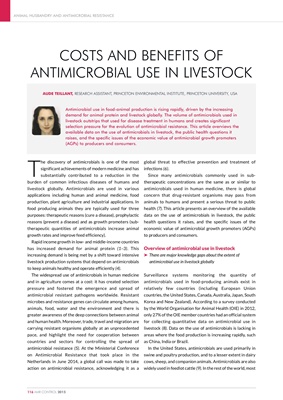
T
he discovery of antimicrobials is one of the most
significant achievements of modern medicine and has
substantially contributed to a reduction in the
burden of common infectious diseases of humans and
livestock globally. Antimicrobials are used in various
applications including human and animal medicine, food
production, plant agriculture and industrial applications. In
food producing animals they are typically used for three
purposes: therapeutic reasons (cure a disease), prophylactic
reasons (prevent a disease) and as growth promoters (subtherapeutic
quantities of antimicrobials increase animal
growth rates and improve feed efficiency).
Rapid income growth in low- and middle-income countries
has increased demand for animal protein (1-3). This
increasing demand is being met by a shift toward intensive
livestock production systems that depend on antimicrobials
to keep animals healthy and operate efficiently (4).
The widespread use of antimicrobials in human medicine
and in agriculture comes at a cost: it has created selection
pressure and fostered the emergence and spread of
antimicrobial resistant pathogens worldwide. Resistant
microbes and resistance genes can circulate among humans,
animals, food, water and the environment and there is
greater awareness of the deep connections between animal
and human health. Moreover, trade, travel and migration are
carrying resistant organisms globally at an unprecedented
pace, and highlight the need for cooperation between
countries and sectors for controlling the spread of
antimicrobial resistance (5). At the Ministerial Conference
on Antimicrobial Resistance that took place in the
Netherlands in June 2014, a global call was made to take
action on antimicrobial resistance, acknowledging it as a
global threat to effective prevention and treatment of
infections (6).
Since many antimicrobials commonly used in subtherapeutic
concentrations are the same as or similar to
antimicrobials used in human medicine, there is global
concern that drug-resistant organisms may pass from
animals to humans and present a serious threat to public
health (7). This article presents an overview of the available
data on the use of antimicrobials in livestock, the public
health questions it raises, and the specific issues of the
economic value of antimicrobial growth promoters (AGPs)
to producers and consumers.
Overview of antimicrobial use in livestock
‰ There are major knowledge gaps about the extent of
antimicrobial use in livestock globally
Surveillance systems monitoring the quantity of
antimicrobials used in food-producing animals exist in
relatively few countries (including European Union
countries, the United States, Canada, Australia, Japan, South
Korea and New Zealand). According to a survey conducted
by the World Organisation for Animal Health (OIE) in 2012,
only 27% of the OIE member countries had an official system
for collecting quantitative data on antimicrobial use in
livestock (8). Data on the use of antimicrobials is lacking in
areas where the food production is increasing rapidly, such
as China, India or Brazil.
In the United States, antimicrobials are used primarily in
swine and poultry production, and to a lesser extent in dairy
cows, sheep, and companion animals. Antimicrobials are also
widely used in feedlot cattle (9). In the rest of the world, most
COSTS AND BENEFITS OF
ANTIMICROBIAL USE IN LIVESTOCK
AUDE TEILLANT, RESEARCH ASSISTANT, PRINCETON ENVIRONMENTAL INSTITUTE, PRINCETON UNIVERSITY, USA
ANIMAL HUSBANDRY AND ANTIMICROBIAL RESISTANCE
116 AMR CONTROL 2015
Antimicrobial use in food-animal production is rising rapidly, driven by the increasing
demand for animal protein and livestock globally. The volume of antimicrobials used in
livestock outstrips that used for disease treatment in humans and creates significant
selection pressure for the evolution of antimicrobial resistance. This article overviews the
available data on the use of antimicrobials in livestock, the public health questions it
raises, and the specific issues of the economic value of antimicrobial growth promoters
(AGPs) to producers and consumers.